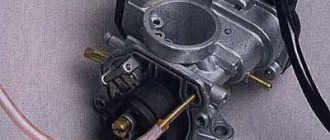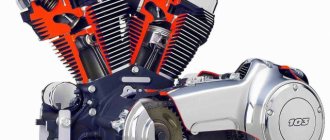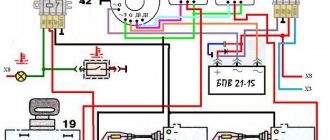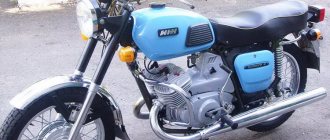The normal operation of a scooter at idle speed depends on many factors, including the condition of the piston, spark plug, carburetor, air filter, muffler, switch, hall sensor, etc.
To know for sure the reason for the unstable idle of your scooter, you need to carry out a series of operations to identify the breakdown and make solutions to fix the problem.
Let's start checking. Adjust the idle speed of your scooter and watch what happens next. Let's look at three possible developments point by point.
Moscow Scooter Club
Time zone: UTC + 4 hours [Summer Time]
Forum Rules
BE SURE to indicate the model, unit and symptoms of the malfunction in the title of the topic.
Heading form: [SCOOTER MODEL] - unit malfunction Example: [Dio] electric starter does not work.
If the topic concerns general repair issues, the model may not be specified.
The main rule is that the title of the topic should be brief, but as fully as possible reflect its content. Topics whose title does not indicate at least the approximate essence of the question, such as “AAA. Save!”, “I have a problem, tell me,” will be DELETED .
Stalls at idle
_________________ Driving KYMCO through KYMCO, sees KYMCO in the river KYMCO put KYMCO in the river KYMCO KYMCO KYMCO KYMCO (c)
. cold is cold, and WARM POOP is on schedule! (With)
In the Lefortovo tunnel, all fifty dollars are worth a hundred. (With)
I apologize, I looked on the Internet what an enrichment agent is. I don’t know what condition it is in, but judging by the description, it looks like the first described case of “the position of the extended needle.”
“Which should make you wonder if your starter enricher is faulty. Let's look at the main reasons: The scooter is difficult to start in the morning; The scooter is difficult to start after parking; The scooter consumes an excessive amount of gasoline; The scooter does not idle; After warming up it works normally, but when cold it works with significant interruptions.”
“The enrichment malfunction also has two positions, this is when the solenoid valve is constantly in the extended needle position (1) or in the initial position of a cold engine - that is, when the needle is constantly retracted (2). Both cases have completely different consequences for engine performance. In the first case, the scooter does not start when cold, several kick movements do not produce results, and the scooter does not start with the wiper. In the second case, the scooter starts up normally, but consumes a lot of gasoline and constantly operates in a rich mixture mode, with consequences arising from this.”
Diagnostics
Checking the power plant is done in this way.
Fastenings
Check that all bolts are in place and that they are tightened. Sagging cushions and loose axles in 60% of cases provoke the transfer of vibration to the body, imbalance of the internal combustion engine.
Fuel system
Checking the fuel lines is necessary to eliminate air leaks. Leaked bubbles are the primary source of interruptions in the normal engine stroke. For example, on a VAZ 2110 the “sore” is located in the fastenings of the fine fuel filter. It is also necessary to diagnose the carburetor or injector. A grain of sand stuck in an injector or jet prevents the normal flow of gasoline and disrupts the operation of the installation.
Electrics
The most common category of diseases is found in the electrical circuits of the machine. Here the master is required to consistently study the entire structure, from spark plugs to the ignition coil. On the injector you need to look at the ECM and then the ECU.
It is also important to measure the fuel rail pressure for the injector.
Motorcyclist
The normal operation of a scooter at idle speed depends on many factors, including the condition of the piston, spark plug, carburetor, air filter, muffler, switch, hall sensor, etc.
To be sure to find out the cause of the unstable idle speed of your scooter, it is necessary to carry out a series of operations to identify the breakdown and making decisions to troubleshoot problems.
Let's start checking . Adjust the idle speed of your scooter and watch what happens next. three possible developments point by point :
1. Even after adjustment, the scooter engine runs at high speeds . First, you need to make sure that the throttle of your scooter is completely closed to prevent under-throttle. If the throttle is not completely closed, you need to check the adjustment of the throttle control cable (throttle) and adjust the cable properly. However, if the damper is closed, and the speed is still high and cannot be adjusted, you need to check the idle jet in the carburetor to ensure it corresponds to the required markings, namely, the required diameter for a particular scooter model. 2. The scooter operates unstably at idle , despite manipulations with the settings. In this case, you first need to check the ignition timing for compliance with the standards. If deviations are detected, the switch, hall sensor, and electrical wiring must be checked. If the ignition timing is normal, the first thing to pay attention to is the gap between the spark plug electrodes. If the gap does not correspond to the nominal one, it must be determined as such, and if the gap and spark plug are normal, the composition and quality of the fuel mixture, regulated by the carburetor, must be checked. 3. The scooter does not idle , despite numerous attempts to adjust the idle speed. In this case, the first thing you need to pay attention to is compression. In the absence of normal compression, achieving a stable idle is simply unrealistic. If you find that the compression is very low, check the tightness of your scooter's CPG, check all gaskets and bolt tightness. Check the piston rings for wear. If the compression is still normal, we switch to the idle jet. In such cases, it is often clogged with dirt, which means cleaning the carburetor is simply necessary. Even if after cleaning the carburetor it is not possible to get the scooter to idle, be sure to check the fuel level in the float chamber and, if necessary, adjust it. In addition, if the problem has not been solved , it is necessary to inspect the carburetor mount, making sure that there are no various damages. The vacuum tube of the fuel valve and the plate valve are also subject to inspection.
How to stabilize floating speed
- Penetration of foreign air into the engine. It is necessary to check the tightness of the air system channels with the intake manifold. For such purposes, it is necessary to dismantle each hose separately and pump it with a pump or compressor, but you can try spraying liquid -40 on the hoses, where it will quickly evaporate; there is most likely a crack in the hose. In such a situation, it is better to replace the damaged hose with a new one rather than wrap it with electrical tape.
- Replacement of IAC. The condition of this device is checked with a conventional multimeter, which needs to check its resistance. If the resistance readings are in the range of 40-80 Ohms, the regulator is faulty and such a device requires immediate replacement.
- Cleaning the valve and elements of the engine ventilation system. In this case, you will have to disassemble the oil sump and get to the ventilation valve. It should be pulled out and washed in a product for cleaning engine elements from an oil film. You can use regular kerosene. Next, dry the valve thoroughly and then put it in its place.
- Replacing the air flow sensor. This is the most delicate part and most often cannot be repaired. Therefore, if the cause is the air flow sensor, then it is advisable to replace it. It is known from practice that even professionals cannot repair a hot-wire anemometer.
- Flushing the throttle valve and then installing it in the correct position. There are two methods for cleaning the throttle valve from oil contaminants: without removing it from the car, and also with removing the throttle valve. When removing the damper from the car, you must disconnect all wires and hoses from the damper, loosen it and pull it out. Next, place it in a container and fill it with cleaning aerosol. If the oil stains on the surface of the throttle valve are already old, you can clean them with a brush. Next, dry the damper surfaces with a rag and put them in place, connecting all the wires and hoses. If the damper is not removed from the car, then it can be washed on a hot power unit with a similar aerosol. Before spraying cleaning agent, disconnect power from the throttle valve. First you need to pour the product inside the throttle valve, wait a few minutes and start the engine. With the power unit operating, continue cleaning the damper with the same product. If, during such cleaning, white smoke comes from the damper, then this is normal, since oil contaminants are cleaned in this way. At the end of the work, you should connect the wires and adjust the operating order of the throttle valve on the computer, setting the required opening gap.
- Idle speed adjustment. This procedure can be carried out using a regular screwdriver, adjusting the screws for the quality of the fuel mixture and the number of engine revolutions.
- Replacing the solenoid valve. If the carburetor idle valve malfunctions, the engine can only operate when the choke handle is pulled out. Therefore, in order to prevent idle speed fluctuations, it is advisable to replace the valve with a known good one or a new one.
- Cleaning the idle air jet. Even in the old days, cleaning the jet from oil deposits was considered a very labor-intensive task. Currently there is no need to remove the jet from the carburetor. To do this, you just need to pour a specialized product into it, designed for cleaning carburetors, and wait in this state for several minutes. Then you need to clean the nozzle from dirt using compressed air.
- Treatment of parts of the fuel pump on a diesel engine from rust. To perform this task, you will need a specialized corrosion cleaning agent. This can be either an imported or a domestic product. It is simply sprayed into the fuel tank by opening its neck before refueling with diesel fuel at a gas station. The cleaning agent will clean the pump parts from rust on its own. In order to prevent similar corrosion of the high-pressure pump in the future, it is recommended to pour a glass of motor oil into the tank, which can form a protective film on the surface of the pump parts when moving.
You need to know that if uneven engine speed occurs at idle, you must immediately contact a service station and carry out detailed diagnostics of the operation of all engine systems. Timely detection of faults will protect you from costly repairs.
Why does my scooter stall?
The operation of a scooter can be quite unpredictable, even despite the simplicity of the engine and the entire design. But when a breakdown occurs, it is sometimes quite difficult to determine the cause and make repairs. One of the most common problems is when the scooter stalls. This can happen in two cases - while driving and while idle with the engine running. Many people ask: why does the scooter start and stall? Experts identify three main reasons - carburetor, spark plug and wiring.
Problems with powertrain control calibrations
Very often, a breakdown of any sensor, ignition module, is displayed by a message on the instrument panel. However, there are exceptions when all mechanisms operate normally. There seem to be no malfunctions, but the engine still jerks when reaching speed. In this case, incorrect ECU calibration is to blame.
By the way, such symptoms do not always appear. Most often this happens when the engine is not warmed up enough. I had to observe when a cold engine experienced failures during acceleration. The reason for this behavior was the insufficient supply of fuel to the cylinders.
The way out of the situation is to update the software, which will not contain errors and will work without failures. Regarding the rest of those involved in acceleration jerks, not counting the injectors that have worn out over time and the faulty module - everything is fixable and does not pose a serious threat
It is important to promptly identify such a problem and eliminate it.
If we talk about turbocharged engines, jerks when the car moves are caused by the turbine itself. The weak point of the part is the pressure adjustment system, namely the electric drive, the electromagnetic valve element. The problem disappears after replacing the valve. Another question is when you have to completely change the turbine.
Reason 1: candle.
It is because of the spark plug that the most frequent breakdowns occur, when the scooter starts and stalls. There are electrodes on the spark plug, and when soot accumulates between them, the spark on the spark plug cannot work properly; in advanced cases, the spark does not pass through at all. If there is an incorrect gap, the spark plug will form a short circuit. This is what explains why the scooter stalls while driving - the spark does not come due to carbon deposits or a gap.
To avoid such malfunctions, we recommend monitoring the condition of the spark plug and, if possible, measuring the gap; this indicator should vary from 0.6 to 0.7 mm. At lower values, the spark plug will not work properly and will soon fail completely. If the gap is higher than these values, the spark plug will consume much more electricity, and the scooter's inability to produce this value will result in the inability to get a spark. Also, to avoid carbon deposits, we recommend sometimes driving at higher speeds, in which case the spark plug will clean itself. See in more detail here ⇒ why there is no spark on the scooter
Reason 2: carburetor.
A fairly common reason when a scooter starts and immediately stalls is an incorrectly configured carburetor. It is important to adhere to the exact parameters of the carburetor, because it must supply fuel in accordance with the characteristics of the engine; before using the scooter, check the jets, the level of the float chamber, and the level of the needle. Some scooter riders note that the scooter stalls while driving after one of the jets has come loose.
Also, after disassembling and cleaning the carburetor, the scooter owner may damage the float or install the needle incorrectly. In some cases, the engine stalls due to lack of air entering the carburetor. Thoroughly clean the air filter and, preferably, the carburetor itself. If you are not sure that the problem is in the air filter, just unscrew it and start the scooter. If it works without it, you will have to clean it. In another case, water enters the carburetor and mixes with the fuel. The scooter may not start at all or stall when starting to move. It is enough to drain gasoline from the float chamber and pump in new one.
Reason 3: electrical wiring
Sometimes owners notice that the reason when the scooter heats up and stalls is due to moisture getting into the devices or electrical wiring. In this case, the wiring is not able to function normally and, accordingly, produce a spark. The simplest thing you can do yourself is to simply dry the devices and wiring from moisture. It is also recommended to insulate the wiring with insulating tape; if all this does not help, then a more in-depth analysis of the electrical system is needed. See also the wiring diagram for Chinese 4T scooters
Does your scooter stall while driving?
Imagine the situation: you are riding a scooter, and suddenly it stalls and starts again. The reason is precisely the spark, or rather the peeling of carbon deposits from the electrode. When this action occurs, the scooter loses its spark and, accordingly, stalls. But when you move, the scooter operates at high speeds, which means the spark plug can clean itself of carbon deposits. The best way would be to replace the spark plug with a new one; its cost is quite low, but it will help solve this problem.
Why does my scooter stall at idle?
Good afternoon, I got a qingqi qm50qt - 5n scooter with a Suzuki engine (75 cc), there are some problems: 1st It doesn’t start with the button, only with the kick it’s very difficult, you have to pull for about 15 minutes and the spark plug fills. After warming up, it starts normally, but again not with the button (the battery is fully charged). The 2nd engine stalls at idle, and when it is just started and the scooter is not yet warmed up, it still holds on, but after driving and stopping, it immediately stalls.
The carburetor was cleaned. and in general for some reason there is only one regulator on it (I don’t know why, since I’m not good with mopeds)
The quality screw and XX stroke need to be adjusted... I had something similar. Doesn't start with the button - does it turn the engine? If it turns quickly and does not start, the compression sign is
I was repairing one Suzuki AP, there was also the same problem, your electronic enrichment valve was simply closed and on that carb there was also no screw for adjusting the mixture quality, but only an idle speed adjustment screw. The idle speed needs to be adjusted on a well-warmed engine. And so that it started easily, you need to change the valve or when you start it, cover the air supply with your hand, I did this right on the air filter and then it starts right away, but you need to warm up the engine a little more, otherwise when you remove your hand it will stall again. Or you just have a crap piston and you have no compression.
Autovitaliy
, not necessarily a starting enricher, but it’s worth checking it, especially since it’s very easy. The reed valve may be damaged and the worst option is dead crankshaft seals. As I understand it, the engine is two-stroke or am I mistaken. If it’s a two-stroke, then my recommendations are correct.
Yes, the engine is two stroke. Thank you all for the advice, as soon as I figure out what’s funny I’ll be sure to write back
kiddie
, post a photo of the engine, it’s interesting to see (at least a couple so that you can look at it from different angles)
ok, I'll take a photo tomorrow and post it
Mine also bothers me, then the idle is crazy, I turn the screw a little and it’s fine, over time it starts to stall at idle, I tighten the screw so that I keep the idle for a minimum, over time they become crazy and so on. WTF? I actually drove 800 km after the overhaul, maybe I haven’t run it in yet?
Maybe it hasn’t been broken in yet, I’ve had the same stall until 500 km from birth.
You can look at the rings, but it's hard to take them apart
Well, yes, it’s true that my throttle cable has already torn in the handle twice, I molded it as best I could, now it’s constantly under tension, maybe it’s getting snagged? And the gasket on the carburetor cap where the needle is inserted is all chewed up.
Golden mean
One of the most popular developments on the towing market belongs to Apollo. At first glance, the characteristics of the Apollo AV-1 do not stand out in any way: speed up to 3.8 km/h, operating time from 45 to 60 minutes. True, the working depth is greater, up to 50 meters. Why then such a high price - about 2000 dollars.
And the difference between expensive and cheap towing vehicles is about the same as between a foreign car and a Zhiguli. The AV-1 has additional convenience and safety features. There are three different speeds, so you can control the pace of your movement. There is a temperature sensor that prevents the engine and battery from overheating, and if water gets inside, the towing vehicle will turn off instantly. If something foreign gets under the propeller grille, a special clutch will work and the propeller will not harm you.
There is a special saddle for this towing vehicle, using which you can move through the water with minimal resistance.
Finally, it is also important that the AV-1 has been in production for more than 15 years. Hence its high reliability and excellent reputation.
The tug, produced by Dacor under the name Seasprint, is completely similar to the Apollo AV-1.
But the low battery indicator is certainly a useful device. Mako also has a protective clutch in case foreign objects get under the propeller, and a saddle for riding. It allows you to reach a speed of 4.3 km/h and move at this speed for 40 minutes. Well, if you are satisfied with a lower speed, the towing vehicle can work for up to 2 hours. It is quite possible to swim up to 5 km on one battery charge with the help of Mako. The maximum depth for this towing vehicle is 50 meters, and it costs about $2500.
Finally, one more original development cannot be mentioned. This device is called Aquanaut SPU, it allows you to turn into an “underwater Carlson”. The device attaches to the bottom of the tank, its weight allows you to do without a weight belt or reduce the amount of weight, and best of all, it leaves your hands free so you can hold a camera or video camera while cutting through the ocean.
Aquanaut has two speeds. If you're moving fast (up to 4.8 km/h), the batteries last for 30 minutes, and at low speed you can swim this way for up to 70 minutes. Using your body as a rudder, you can achieve amazing maneuverability with this tow, and it takes 2 to 6 hours to charge, meaning it's quite possible to charge the batteries during the surface interval between two dives.
Considering that the working depth of the Aquanaut SPU reaches 100 meters, and it costs from $1000 to $1400, this towing vehicle can be a profitable purchase. Aquadyn calls its brainchild a revolutionary achievement in the field of DPV design and, perhaps, it is so.
The scooter stalls when adding gas: what to do?
Many scooter riders who have been using the same scooter model for several years must have encountered a problem where the scooter either does not start or starts but stalls after adding gas. What is this problem and what is its solution, we will consider in this article.
If you have this problem, it will be extremely difficult to fix it without special knowledge. The first step is to make sure that certain parts are working, so you should do the following:
- configure and adjust the carburetor;
- check the air filter;
- check compression, replace rings if necessary;
- check the spark on the spark plug;
- adjust the float on the carburetor;
- check the relay, generator and coil;
- as a last resort, try to replace the carburetor.
Cleaning and adjusting the carburetor
If you don't know why the scooter stalls when you give it gas, first check and adjust the carburetor. If it was often removed and adjusted, it may be that somewhere it began to leak air. If such a problem occurs, you can use a sealant or buy gaskets for the carburetor.
Let’s say the scooter stalls, you don’t know what to do. Then the first thing we do is clean the carburetor. Mostly the jets and auxiliary systems become clogged with dirt, so after cleaning the carburetor and adjusting all the jets, you can try to start the scooter again and give it gas. If the problem is not solved, move on to the main action - adjusting the needle to adjust the quality of the mixture. The needle in the carburetor performs the main task - adjusting the amount of fuel that is then supplied to the combustion chamber. Basically, you can adjust the quality of the mixture using a special jet on the carburetor, but if working with it does not produce results, you will have to manipulate the needle.
The needle is in close contact with the throttle handle, so when the handle is opened, the needle rises up and allows fuel to be supplied. That is, the higher the needle is raised, the more gasoline flows in and the power increases. Power guarantees better speed and traction. If you disassembled the carburetor, taking out the needle you will see 5 grooves on it, one of which has a retaining ring installed. Typically, such a ring is located in the center, that is, on the 3rd groove. If you lift the locking ring up, the needle will drop lower. This allows a leaner mixture to be supplied to the evaporation system, in which more air is supplied than gasoline. When installing the ring on the 4th and 5th grooves, the mixture becomes richer, where more gasoline is supplied than air.
Be careful that if you put the ring up or down as much as possible, this will not give the best result; the adjustment must be done gradually. Otherwise, the scooter will overheat, there will be a loss of power, and our main problem is that the scooter will stall when you press the gas handle. To find out the quality of the mixture, check the spark plug; its color will indicate whether the mixture is rich or lean.
Please note that there may also be other reasons why the scooter stalls when applying gas. Above we indicated the main ones; for some, the scooter stalls due to improper operation of the generator. Try, adjust, and share your problems and how to solve them.
Video
Adjusting the quality of the mixture.
It is very important that the fuel mixture on which the scooter operates corresponds to the proportions specified by the engineers. If the mixture is too lean, the scooter does not work properly, overheats, and loses power.
With a rich mixture, there is increased fuel consumption, the formation of soot in the combustion chamber, and the carburetor is usually wet.
The quality of the mixture can be adjusted either by adjusting the screw or by moving the needle in the throttle valve. In the photos above you can see the location of the mixture quality screw. If it is absent, adjustment is carried out only with a needle.
By turning the screw clockwise, we enrich the mixture, and by unscrewing it counterclockwise, we lean it. It’s the same with a needle, raising the needle makes you rich, lowering it makes you poorer. The combination of both methods allows us to achieve the most acceptable results when tuning, however, in the absence of the first, as for example on Suzuki Sepia and Suzuki Assress carburetors, we will be content with only moving the needle. And thanks for that.











